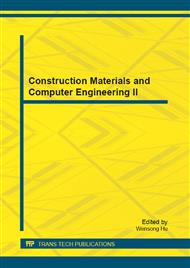p.3
p.9
p.15
p.21
p.27
p.31
p.35
p.43
The Feasibility Research on Producing Lightweight Aggregates Made from the Waste Stone Sludge
Abstract:
This paper aims to investigate on producing lightweight aggregates made from the waste stone sludge. It was utilizing the mechanism of high temperature solid solution method as well as in coordination with the production method of reservoir sediments lightweight aggregates to conduct an investigation on the development of lightweight aggregate using stone sludge. The investigation shows that the analysis results for the stone sludge are not in the limits of the expandable region of the ternary diagram due to the high content of FeOx. That caused the expandable temperature range was narrow, the expandability of aggregate was poor and the aggregate particle density was relatively high. But, it still could be producing lightweight aggregates made from the waste stone sludge in this paper. The better solution may be to add the high-content organic materials to adjust chemical composition, such as water purification sludge, sewer sludge, reservoir sludge etc.
Info:
Periodical:
Pages:
3-8
Citation:
Online since:
July 2013
Authors:
Keywords:
Price:
Сopyright:
© 2013 Trans Tech Publications Ltd. All Rights Reserved
Share:
Citation:


